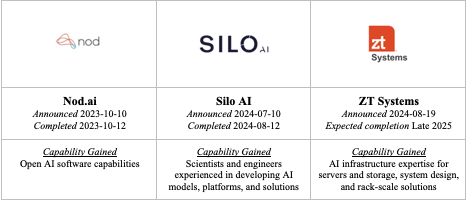AMD’s acquisition of ZT Systems is the most recent of multiple acquisitions that are part of a strategic effort to strengthen end-to-end AI capabilities. This comes on the heels of the acquisitions of Nod.ai (completed in October of 2023) and Silo AI (completed earlier this month). The acquisition of Nod.ai provides open-source AI software capabilities, while Silo AI augments personnel with experience in developing AI models, platforms, and solutions. The acquisition of ZT Systems, scheduled to be completed in late 2025, will provide AI infrastructure expertise with servers and storage, specifically with systems design and rack-scale solutions.
What It Means
These acquisitions may not help AMD with the semiconductor manufacturing and resulting AI infrastructure constraints, but they will enable AMD to provide more product integration and a better end-to-end user experience with AI. With these acquisitions, AMD builds end-to-end AI capabilities from chips and systems to open-source software and models. The potential exists for AMD to leverage user feedback to drive AI innovations at every level with excellent and trained expert resources. This puts them in a better position to compete with NVIDIA in the following ways:
- Semiconductors. NVIDIA has locked out its competition from using the best fabrication processes offered by TSMC (Taiwan Semiconductor Manufacturing Company Limited), but AMD is still able to sell all of its AI accelerators as an alternative and can potentially build a foothold by providing better value.
- Infrastructure. AMD now has expertise in-house to help provide system and solution design services for hyperscalers and enterprises. As we see a slowdown in semiconductor optimizations in fabrication processes and AI accelerator architectural approaches, look for optimization to come from higher abstraction layers.
- Open-source software. AMD is leveraging open-source software to make AI work better on AMD products to create a viable alternative to NVIDIA’s software development ecosystem. As new AI tools and platforms are developed, support for them across all relevant platforms is a necessity. Tools to improve user experience and optimize performance will help with adoption.
- Models, platforms, and solutions. AMD now has scientists and engineers targeting models and solutions for their products. New models, platforms, and solutions will continue to be developed and require support across all relevant platforms. Optimizations to improve user experience, ease deployment at scale, and boost performance on each platform will help with adoption.
The pace of change in the AI market shows no sign of slowing down, so expect further merger and acquisition activity in the AI semiconductor and infrastructure market.
Source link
lol

